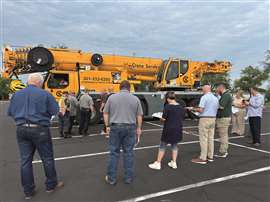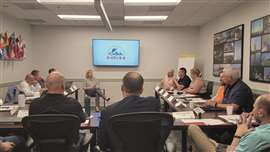How SC&RA shaped the future in 2024: advocacy, engagement and strategic growth
02 December 2024
At the core of SC&RA’s mission each year is an unfailing commitment to advocacy and member support, ensuring that specialized carriers, crane, and rigging professionals not only meet today’s demands but are also prepared to tackle tomorrow’s opportunities.
“And it was no different in 2024,” said SC&RA CEO Joel Dandrea. “The Association spent six months examining our entire list of programs – what we do, how we do it – and assessing feedback.”
 Members of the Strategic Planning Group met at SC&RA headquarters in June.
Members of the Strategic Planning Group met at SC&RA headquarters in June.
From that examination, explained Dandrea, three strategic objectives emerged: advocacy, communication and member engagement. “Ultimately, the Association Board approved a new strategic plan, with a key focus on expanding our advocacy ecosystem. As we move forward over the next five years, we’ll broaden and deepen efforts to address member issues and drive engagement.”
One key issue involves insurance. “It remains a tough challenge for our members,” Dandrea noted. “In 2024, we developed a white paper on the hard market and higher costs. Out of that, the Insurance Committee suggested a survey to determine how members are buying insurance and covering risk.”
SC&RA looks forward to the survey results, which Dandrea described as “… an important step to helping members and insurance partners navigate the insurance landscape.”
Looking ahead to 2025, Dandrea highlighted estate tax changes and continued focus on cybersecurity and AI. “The estate tax session we’re planning for the 2025 Annual Conference will be crucial for many of our owners, especially family businesses, to understand how tax changes could affect ownership transition.
“And we know that cyber and AI are on the radar globally. In response, we’re assessing a cyber/AI affinity partnership to provide members with better insights and intelligence on these topics.”
Face to face
SC&RA Membership Director Jason Bell reported that membership value was again evident in 2024, demonstrated by a long-term retention rate of 92 percent and a 15 percent increase in new member applications compared to 2023.
“That long-term rate for other associations is around eighty-eight percent, and many are seeing declines – while we’ve held steady,” he indicated. “Additionally, our second-year members currently renew at seventy-five percent, and we aim to push that into the eighties. Retaining those first-year members will be critical as the industry faces transitions like mergers and retirements.”
Bell also pointed to growth in SC&RA’s Membership Directory, with a three percent increase in premium listings and sales. This enthusiasm extended to strong attendance at SC&RA’s 2024 Crane & Rigging Workshop in September, with a 10 percent increase over 2023, totaling around 700 attendees.
“Our members truly want to connect face to face, especially when it comes to preparing for multi-state hauling jobs or critical lifts that require extensive engineering,” Bell explained. “Trust is built in person, and it’s a cornerstone of our industry.”
Moving forward, he added, SC&RA will continue to emphasize next-generation leadership through initiatives like the 4 Under 40 Recognition Program and the Emerging Leaders Summit. “The quality of applicants has been amazing. These young leaders are eager to contribute and make their mark.”
Strengthening efforts
It was a busy year for crane and rigging advocacy. SC&RA published its guide to “Understanding Mobile Crane Bare Rental Agreements” in early 2024 and launched the “Guide to Outrigger Pad Materials, Selection and Usage” at the Crane & Rigging Workshop.
 Crane Service Co. traveled to SC&RA headquarters earlier in the year to demonstrate variations of weighing mobile cranes.
Crane Service Co. traveled to SC&RA headquarters earlier in the year to demonstrate variations of weighing mobile cranes.
“Formal comments were submitted to OSHA through the Construction Industry Safety Coalition regarding a potential standard for heat injury and illness prevention in outdoor and indoor work settings,” said Beth O’Quinn, Senior Vice President, Crane & Rigging. “We believe the standard – if adopted – must be flexible and performance-based.”
An example of SC&RA’s state-level work, she noted, is its recent formal comments to the Washington State Department of Labor addressing HB 2022, which increases regulations around tower crane operations to prioritize safety.
O’Quinn also noted that SC&RA, as a member of the International Crane Stakeholders Assembly, continued its work in the development of international guidance documents for the crane industry, with the 2024 publication of “Safe Crane Operations in the Vicinity of Power Lines.”
Launched in 2024, she added, SC&RA’s Mental Health Awareness Initiative received positive member feedback. “Recognizing that many in our industry hesitate to seek help due to the stigma surrounding mental health, SC&RA developed resources including 988 chips and hardhat stickers, and a list of resources for individuals and companies facing these challenges.”
Steady gains
On the transportation side, SC&RA’s advocacy efforts in 2024 were significant. Chris Smith, Vice President, Transportation, highlighted one recent issue: “We’re tackling bicycle lanes being placed over OS/OW and general trucking routes in New York City.”
Smith explained that SC&RA is mobilizing carriers to oppose these efforts, submitting comments and organizing coalition meetings with NYCDOT. “OS/OW routes are already hard to come by. The point we’re making is not to take away the ones we already have.”
Permit harmonization remains a focus, he acknowledged, with SC&RA’s Permit Policy Committee continuing to target Massachusetts, California, Oklahoma, Kansas and Tennessee. However, Smith pointed to several other state-level wins this year. “Illinois now recognizes stacked jeeps and boosters as non-divisible loads for interstate travel, aligning with its neighbors. Kansas also removed its three-day hold on superload applications.
“Additionally, North Carolina improved its escort certification program, authorizing operators under twenty-one and allowing carriers to train escorts to state standards. They also enacted fourteen feet as legal height.”
 Members of the Permit Policy and Transportation Governing Committee met this summer to discuss the latest on permit policy across the states and provinces.
Members of the Permit Policy and Transportation Governing Committee met this summer to discuss the latest on permit policy across the states and provinces.
Smith mentioned, as well, that Tennessee now recognizes 53 feet as legal load length – though superload permit delays within the state remain an issue. “I’d add that Maryland now auto-issues permits for loads up to fourteen feet wide,” he explained, “aligning with SC&RA’s UPT2021 standards. And Wyoming recently adopted twenty-four-seven auto-issue – which checks off another box.”
Smith noted that as loads get larger and heavier, automation is being pushed as far as possible. “However, there are some permits that will always need human interaction between both the applicant and the state.”
Moreover, SC&RA is addressing what Smith called “draconian enforcement,” where penalties far exceed the severity of the violations. “We’re looking at what the appropriate level of enforcement is as an industry – what’s reasonable, what’s fair.”
Smith then pointed out that North Dakota commissioned a study to evaluate the pavement impact of trunnion trailers versus tridems. “If successful, it could convince states like Colorado, Utah and Oklahoma to permit trunnions like tridems,” he said. “This will be significant, as SC&RA members are providing equipment for the study.”
Along those lines, SC&RA’s grassroots efforts were reinforced through their participation in the annual Trucking Association Executives Council (TAEC) meeting in July. “The meeting helps us with on-the-ground advocacy in every state,” Smith explained, highlighting the importance of collaboration with state trucking associations to support advocacy initiatives nationwide.
On the education front, Smith noted that the Permit Policy Committee is exploring mobile crane weighing with portable scales. “As equipment gets larger and more complex, fewer officials understand the technology, leading to inconsistent enforcement. We’ll work on educating our public partners about this in 2025.”
Ultimately, Smith confirmed that many of these topics will be covered at the 2025 Specialized Transportation Symposium, set for February 18-20 in Charlotte, NC. “We’re excited for this year’s event, held in the home state of Transportation Group Chair David Yarbrough, of Yarbrough Transfer. David has been very active in North Carolina for years, and we consider him a true asset to the Association.”



